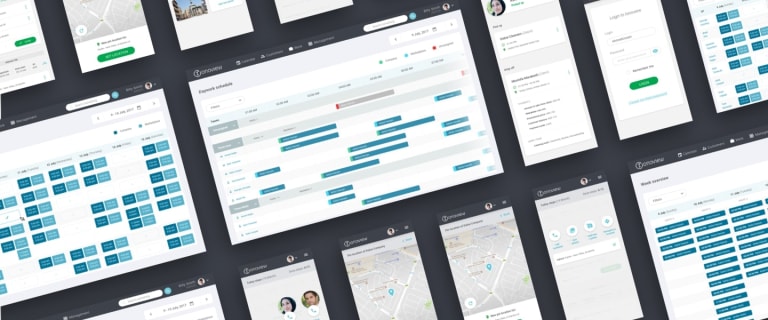How finding your product market fit can help you increase ROI of your product?
Growing your digital product isn’t a straight line. Sometimes, it’s a struggle to grow it beyond its basic features and a few hundred users. In this article, we will tell you how to find the next revenue stream for your digital product, and how we contributed to the success of one of our clients.

Table of contents
How does finding your product-market fit can help you avoid hitting a dead end?
Imagine this: you have a working version of your digital product with a positive ROI. You also have an engaged group of users who give constant feedback that gives you input to your product backlog. But you can’t see a definitive direction in which your product should be growing.
The above scenario describes a product that is ready for entering the product-market fit phase. In the digital development world, this is a phase when:
your product meets real customer needs and does so in a way that is better than the alternatives (source).
A product that has found its product-market fit transforms into something that answer’s clients’ real needs - and becomes something they will gladly pay for! One of our clients found themselves in a similar situation. We’ll use their example to show you how we got through the product-market fit phase.
Who was our client and what was their problem?
TeamAlert is a US-based company that provides a workplace panic button for private businesses and public institutions. We’ve been partners since 2019 and developed a working version of their product for web and mobile devices.
Of all the users of TeamAlert, about two dozen were giving them feedback and suggestions for different features they would like to see. The problem was that each of these users came from a different market sector, so it was hard to pinpoint the specific needs of each user group. What did we do to change that?
How did we solve the problem?
To solve a problem, we needed to better understand it. The main tool we used to better understand TeamAlert’s situation was the business model canvas (BMC). It’s a basic template that determines what your product (and business) is offering to its users. A full definition of the BMC describes it as:
a simple document with nine boxes representing the core elements of any business model or idea: customer segments, value propositions, channels, customer relationships, revenue streams, key resources, key activities, key partnerships, and cost structure.
Our work with the BMC comes down to conducting a session with a product strategist where we identify our knowledge gaps in each of the nine boxes. In some cases, if we notice that there were more knowledge gaps than we expected, we conduct the session again - but this time with the client. The information that we gather is then used to conduct a series of workshops with the client and our product strategist.
What actions did we take and how did they affect the client’s business?
First, we focused on customer segmentation. We defined the target persona of the ideal user and came up with hypotheses for what their biggest pains and needs are. With that information, we were ready to conduct interviews with potential customers - and find out what other needs they have.
With these new insights, the TeamAlert team was now confident about the direction their product should take. They also had a better understanding of what kind of relationship they should build with their customers and what features they should introduce to achieve that. Growth in both user base and revenue was a direct result of implementing those features.
But, the business model canvas was not the only tool that helped them get there. Here’s more about different workshops that could be useful in this - or a similar- scenario.
Workshops and other tools useful in finding product-market fit
Before we find the product-market fit for the product and expand it to different revenue streams we go through a process that has several steps: mapping out our pool of knowledge of the product, preparing a business model canvas, and conducting a series of workshops with the client. We already explained the BMC, and now we’ll tell you more about the other two.
Pooling our product knowledge
The team put themselves in the product owner’s (PO) shoes and try to answer questions regarding the product’s goal and its place on the market. Some of these questions are:
- What is the motivation for creating the product?
- What problems is it solving?
- Who are the target customers and users? Do we have all personas mapped?
- Who is the competition? Are there any newcomers/ startup players coming to the competitive environment?
- How do you make money with this product?
This is to increase our overall pool of knowledge about the product. Once we have all the information collected in one place, we can move on to preparing the business model canvas.
A series of workshops
Once the BMC is ready, it’s time for a workshop session with a product strategist. The session is called “What is Product-Market Fit?” and its main goal is to make sure that the team and the client know what phase their product is in and that they understand the metrics they will be using. Other workshops include:
- “Product Discovery Workshops” for when the development team meets the product’s vision,
- “Product Market-Fit Release” for when the team comes up with goals and roadmap for the product.
After these sessions, the product strategist has enough information to put together a recommendation of the direction that the product’s development should take.
Is finding product-market fit a one size fits all solution?
This article only shows that in order to find product-market fit understanding your users is key. And while the process can seem complicated and time-consuming, it’s a good investment - it helps you clearly define the best direction for your product to grow. As a result of the PMF phase, your digital product can move on to scaling - a phase where your product (as well as ROI) grows exponentially. Which is what every business aspires to.
Share this article:








